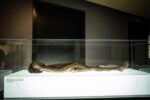Mirko Canesi – Cornucopia
.jpg)
Cornucopia, un intervento specifico di Mirko Canesi a cura di The Workbench sullo spazio di un orto urbano tuttora coltivato, sito nel contesto del Parco delle Cave a Milano.
Comunicato stampa
Il 16 giugno 2017 sul finire della primavera verrà presentato Cornucopia, un intervento specifico di Mirko Canesi a cura di The Workbench sullo spazio di un orto urbano tuttora coltivato, sito nel contesto del Parco delle Cave a Milano. Il progetto è finalizzato alla realizzazione di alcune idee radicali dell’artista sull’integrazione di attività distanti tra loro, in questo caso l’espressione artistica e la pratica della coltivazione.
Nella visione di Mirko Canesi non esistono reali barriere tra parte e parte e il suo scopo è unire ciò che appare incompatibile e distante, facendo co-esistere istanze diverse per creare una terza via, raccontata non attraverso l’artificio artistico ma facendo diventare l’azione artistica stessa un dato esistente e concreto, che calato nel reale esiste e comincia ad innescare nuove dinamiche.
Attraverso l’espediente dell’ “atteggiamento selvatico” l’artista si immedesima in colui che fa esperienza per la prima volta senza riuscire a discernere tra l’elemento naturale e quello artificiale, tra lo spazio di un orto e quello di un museo, arrivando a pensare all’area coltivata come spazio espositivo. Infatti l’idea del progetto Cornucopia nasce proprio dalla riflessione di spazio espositivo nella sua più pura visione meta-artistica, affascinato da un progetto espositivo in divenire che possa contemplare tra le sue variabili la stagionalità e la compresenza di figure umane dedite al loro operato quotidiano nelle pratiche di coltivazione.
Sebbene le mostre non verranno mai realizzate l’intervento site-specific diventa la cifra stilista per la particella ortiva n°147 che prepara l’orto a un diverso destino.
A partire dall’osservazione dell’area coltivata l’artista decide di intervenire con la sostituzione piuttosto che con l’aggiunta, ripensando gli elementi strutturali preesistenti nell’orto e riflettendo sui materiali da utilizzare fino ad operare al limite di una visione pittorico-scultorea sull’intera interfaccia grafica dell’orto.
Il progetto dell’orto si inserisce nel contesto paesaggistico del Parco delle Cave, area completamente mutata dall’intervento progettuale dell’uomo da cantiere estrattivo di sabbia e ghiaia a paesaggio bucolico, da cimitero di automobili della mafia a riserva naturalistica.
<<< All’interno di Cornucopia saranno presenti alcune opere dell’artista della serie “Pls..” e “Laser cut”. >>>
Come raggiungere gli Orti Ghiglio:
Scendere alla fermata Via F.ze Armate Via Nikolajevka Autobus 63 o 67, proseguire su Via Forze Armate, prima del Distributore Agip entrare nella strada sterrata a destra, proseguire per qualche metro e sulla sinistra troverete l’entrata per gli Orti Giglio.E’ possibile prendere il Bus 63 - Direzione Q.re degli Olmi, all’uscita della metropolitana Bisceglie MM1. Oppure prendendo il Bus 67 - Direzione Baggio, all’uscita della metropolitana Bande Nere MM1In ogni caso è consigliato inserire sul vostro smartphone le coordinate GPS: 45°27'40.5"N 9°05’55.2”E.
On June 16th 2017, towards the end of Spring, Cornucopia will be presented. A specific intervention by Mirko Canesi and curated by The Workbench on the space of a currently cultivated urban produce garden, located inside Milan’s Parco delle Cave. The aims of the project are to realise some radical ideas of artist focused on integrating different activities, namely artistic expression and agricultural practice.
True barriers keeping sides separated have no place in Mirko Canesi’s vision, and his goal is to unite that which appears to be incompatible and distant, promoting co-existence between different instances, thus creating a third way. This way is then told not through artistic artifice, rather through having the artistic action itself become an existing and concrete figure, which, when dropped into reality, by existing starts to trigger new dynamics.
Through the expedient of a “wild attitude”, the artist identifies himself in he who experiences for the first time without being able to discern the natural element from the artificial one, between the space of a produce garden and that of a museum, to the point of beginning to see the cultivated area as an exhibition space. Indeed, the central idea for the Cornucopia project came from the reflection on the exhibition space in its purest meta-artistic form, fascinated by the idea of an expositive project in the making that could count among its variables the passing of seasons and the presence of human figures devoted to their daily work in the practice of agriculture.
Despite the fact that no further exhibition will take place in it, the site specific intervention, preparing it to become an exhibition space in its own right, will become the stylistic hallmark for plot number 147.
Starting from the observation of the cultivated area, the artist decides to intervene on it through replacement rather than addition, rethinking the pre-existing structural elements in the produce garden and reflecting on the materials until operating on the verge of a pictorial and sculptural vision on the entirety of the garden’s graphic interface.
The project perfectly fits in the landscaping context of the Parco delle Cave, an area completely mutated by man’s designing intervention, from sand and gravel quarry into bucolic landscape and from Mafia-run automobile graveyard into natural reserve.
<<< Within Cornucopia, some of the artist’s works from the series “Pls..” and “Laser cut” will be present>>
How to reach the Ghiglio Gardens:
Get off at the Via F.ze Armate Via Nikolajevka stop, for busses 63 or 67, then continue on Via Forze Armate. Just before the Agip gas station, take the first alleyway on the right, continue until finding the Ghiglio Gardens entry on the left.
It is possible to take the bus number 63 – direction Q.re degli Olmi, right outside of the M1 metro station Bisceglie.
Alternatively, take the bus number 67 – direction Baggio, right outside the Bande Nere M1 metro station.
It is in any case strongly suggested to input in your smartphone the following GPS coordinates: 45°27'40.5"N 9°05’55.2"E.



